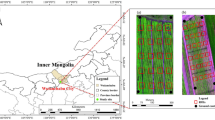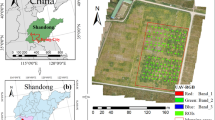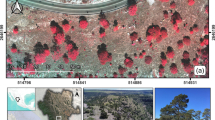Abstract
Canopy Chlorophyll Content (CCC) is an important physiological indicator that reflects the growth stage of trees. Accurate estimation of CCC facilitates dynamic monitoring and efficient forest management. In this study, we used high-resolution remote sensing images obtained by uncrewed aerial vehicles (UAVs) equipped with multispectral sensors (red, green, blue, near-infrared, and red-edge) to estimate CCC of lodgepole pine (Pinus elliottii). Our aim was to determine the optimal machine learning model between support vector regression (SVR) and random forest regression (RFR) for predicting CCC and to evaluate the effectiveness of multispectral bands along with 21 vegetation indices (VIs) in the estimation process. Individual tree boundaries were derived from the canopy height model (CHM) based on three-dimensional (3D) point clouds generated using structure from motion. These images, combined with continuous field measurements from January to December, provided comprehensive data for our analysis. The results showed that the SVR method outperformed the RFR method in estimating leaf chlorophyll content (LCC), with fitting R2 values up to 0.692 and RMSE values up to 0.168 mg⋅g−1. Overall, the study highlights the potential of UAV-based remote sensing for multitemporal forest monitoring, offering advances in precision forestry and tree breeding.








Similar content being viewed by others
Data availability
The data used for this paper is freely available upon permission of Research Institute of Subtropical Forestry, Chinese Academy of Forestry.
References
Awad, M., Khanna, R., Awad, M., & Khanna, R. (2015). Support vector regression. Efficient Learning Machines: Theories, Concepts, and Applications for Engineers and System Designers. https://doi.org/10.1007/978-1-4302-5990-9
Barzin, R., Kamangir, H., & Bora, G. C. (2021). Comparison of machine learning methods for leaf nitrogen estimation in corn using multispectral UAV images. Transactions of the ASABE, 64, 2089–2101.
Blackburn, G. A. (2007). Hyperspectral remote sensing of plant pigments. Journal of Experimental Botany, 58, 855–867.
Breiman, L. I., Friedman, J. H., Olshen, R. A., & Stone, C. J. (2015). Classification and regression trees. Encyclopedia of Ecology, 57, 582–588.
Broge, N. H., & Leblanc, E. (2001). Comparing prediction power and stability of broadband and hyperspectral vegetation indices for estimation of green leaf area index and canopy chlorophyll density. Remote Sensing of Environment, 76, 156–172.
Card, D. H., Peterson, D. L., Matson, P. A., & Aber, J. D. (1988). Prediction of leaf chemistry by the use of visible and near infrared reflectance spectroscopy. Remote Sensing of Environment, 26, 123–147.
Chen, B., Wang, L., Fan, X., Bo, W., Yang, X., & Tjahjadi, T. (2023). Semi-FCMNet: Semi-supervised learning for forest cover mapping from satellite imagery via ensemble self-training and perturbation. Remote Sensing, 15, 4012.
Chen, J. M., & Black, T. A. (1992). Foliage area and architecture of plant canopies from sunfleck size distributions. Agricultural and Forest Meteorology, 60, 249–266.
Chen, J. M., & Cihlar, J. (1996). Retrieving leaf area index of boreal conifer forests using landsat TM images. Remote Sensing of Environment, 55, 153–162.
Chen, J. M., Rich, P. M., Gower, S. T., Norman, J. M., & Plummer, S. (1997). Leaf area index of boreal forests: Theory, techniques, and measurements. Journal of Geophysical Research Atmospheres, 102, 29429–29443.
Chen, Q., Zheng, B., Chenu, K., Hu, P., & Chapman, S. C. (2022). Unsupervised plot-scale LAI phenotyping via UAV-based imaging, modelling, and machine learning. Plant Phenomics. https://doi.org/10.34133/2022/9768253
Ciganda, V., Gitelson, A., & Schepers, J. (2009). Non-destructive determination of maize leaf and canopy chlorophyll content. Journal of Plant Physiology, 166, 157–167.
Clevers, J. (2012). Using hyperspectral remote sensing data for retrieving canopy chlorophyll and nitrogen content. IEEE Journal of Selected Topics in Applied Earth Observations and Remote Sensing, 5, 574–583.
Croft, H., Chen, J., & Zhang, Y. (2014). The applicability of empirical vegetation indices for determining leaf chlorophyll content over different leaf and canopy structures. Ecological Complexity, 17, 119–130.
Curran, P. J. (1989). Remote sensing of foliar chemistry. Remote Sensing of Environment, 30, 271–278.
Curran, P. J., Dungan, J. L., & Gholz, H. L. (1992a). Seasonal LAI in slash pine estimated with Landsat TM. Remote Sensing of Environment, 39, 3–13.
Curran, P. J., Dungan, J. L., Macler, B. A., Plummer, S. E., & Peterson, D. L. (1992b). Reflectance spectroscopy of fresh whole leaves for the estimation of chemical concentration. Remote Sensing of Environment, 39, 153–166.
Cutler, A., Cutler, D. R., & Stevens, J. R. (2004). Random forests. Machine Learning, 45, 157–176.
Gao, D., Qiao, L., An, L., Zhao, R., Sun, H., Li, M., Tang, W., & Wang, N. (2022). Estimation of spectral responses and chlorophyll based on growth stage effects explored by machine learning methods. The Crop Journal, 10, 1292–1302.
Garcia-Gutierrez, J., Martínez-Álvarez, F., Troncoso, A., & Riquelme, J.C. (2014). A comparative study of machine learning regression methods on LiDAR data: A case study. In, International Joint Conference SOCO’13-CISIS’13-ICEUTE’13 (pp. 249–258): Springer
Gholz, H., Vogel, S., Cropper, W., Jr., McKelvey, K., Ewel, K., Teskey, R., & Curran, P. (1991). Dynamics of canopy structure and light interception in Pinus elliottii stands, North Florida. Ecological Monographs, 61, 33–51.
Gitelson, A. A., Gritz, Y., & Merzlyak, M. N. (2003). Relationships between leaf chlorophyll content and spectral reflectance and algorithms for non-destructive chlorophyll assessment in higher plant leaves. Journal of Plant Physiology, 160, 271.
Gitelson, A. A., Kaufman, Y. J., & Merzlyak, M. N. (1996). Use of a green channel in remote sensing of global vegetation from EOS-MODIS. Remote Sensing of Environment, 58, 289–298.
Gitelson, A. A., & Merzlyak, M. N. (1997). Remote estimation of chlorophyll content in higher plant leaves. International Journal of Remote Sensing, 18, 2691–2697.
Gitelson, A. A., Peng, Y., Arkebauer, T. J., & Schepers, J. (2014). Relationships between gross primary production, green LAI, and canopy chlorophyll content in maize: Implications for remote sensing of primary production. Remote Sensing of Environment, 144, 65–72.
Gitelson, A. A., Viña, A., Verma, S. B., Rundquist, D. C., Arkebauer, T. J., Keydan, G., Leavitt, B., Ciganda, V., Burba, G. G., & Suyker, A. E. (2006). Relationship between gross primary production and chlorophyll content in crops: Implications for the synoptic monitoring of vegetation productivity. Journal of Geophysical Research: Atmospheres. https://doi.org/10.1029/2005JD006017
Glenn, E. P., Huete, A. R., Nagler, P. L., & Nelson, S. G. (2008). Relationship between remotely-sensed vegetation indices, canopy attributes and plant physiological processes: What vegetation indices can and cannot tell us about the landscape. Sensors, 8, 2136–2160.
Gu, J., Wang, Z., Kuen, J., Ma, L., Shahroudy, A., Shuai, B., Liu, T., Wang, X., Wang, G., & Cai, J. (2018). Recent advances in convolutional neural networks. Pattern Recognition, 77, 354–377.
Gupana, R. S., Odermatt, D., Cesana, I., Giardino, C., Nedbal, L., & Damm, A. (2021). Remote sensing of sun-induced chlorophyll-a fluorescence in inland and coastal waters: Current state and future prospects. Remote Sensing of Environment, 262, 112482.
Haboudane, D., Tremblay, N., Miller, J. R., & Vigneault, P. (2008). Remote estimation of crop chlorophyll content using spectral indices derived from hyperspectral data. IEEE Transactions on Geoscience & Remote Sensing, 46, 423–437.
Hakala, T., Nevalainen, O., Kaasalainen, S., & Mäkipää, R. (2015). Multispectral lidar time series of pine canopy chlorophyll content. Biogeosciences, 12, 1629–1634.
Hastie, T., Tibshirani, R., Friedman, J., Hastie, T., Tibshirani, R., & Friedman, J. (2009). Random forests. The elements of statistical learning: Data mining, inference, and prediction (pp. 587–604). Springer.
Houborg, R., Anderson, M., & Daughtry, C. (2009). Utility of an image-based canopy reflectance modeling tool for remote estimation of LAI and leaf chlorophyll content at the field scale. Remote Sensing of Environment, 113, 259–274.
Huete, A., Didan, K., Miura, T., Rodriguez, E. P., Gao, X., & Ferreira, L. G. (2002). Overview of the radiometric and biophysical performance of the MODIS vegetation indices. Remote Sensing of Environment, 83, 195–213.
Hunt, E. R., Jr., Daughtry, C. S. T., Eitel, J. U. H., & Long, D. S. (2011). Remote sensing leaf chlorophyll content using a visible band index. Agronomy Journal, 103, 1090–1099.
Iiames, J., Congalton, R. G., Pilant, A. N., & Lewis, T. E. (2008). Leaf area index (LAI) change detection analysis on Loblolly pine (Pinus taeda) following complete understory removal. Photogrammetric Engineering & Remote Sensing, 74, 1389–1400.
Jiang, J., Atkinson, P. M., Zhang, J., Lu, R., Zhou, Y., Cao, Q., Tian, Y., Zhu, Y., Cao, W., & Liu, X. (2022). Combining fixed-wing UAV multispectral imagery and machine learning to diagnose winter wheat nitrogen status at the farm scale. European Journal of Agronomy, 138, 126537.
Jiao, Q., Zhang, B., Huang, W., Ye, H., Zhang, Z., Qian, B., Hu, B., & Wang, S. (2023). The Potential of hue angle calculated based on multispectral reflectance for leaf chlorophyll content estimation. IEEE Transactions on Geoscience and Remote Sensing. https://doi.org/10.1109/TGRS.2023.3322130
Katahata, S.-I., Naramoto, M., Kakubari, Y., & Mukai, Y. (2007). Seasonal changes in photosynthesis and nitrogen allocation in leaves of different ages in evergreen understory shrub Daphniphyllum humile. Trees, 21, 619.
Ke, Y., & Quackenbush, L. J. (2011). A review of methods for automatic individual tree-crown detection and delineation from passive remote sensing. International Journal of Remote Sensing, 32, 4725–4747.
Kokaly, R. F., Asner, G. P., Ollinger, S. V., Martin, M. E., & Wessman, C. A. (2009). Characterizing canopy biochemistry from imaging spectroscopy and its application to ecosystem studies. Remote Sensing of Environment, 113, S78–S91.
Larsen, M., Eriksson, M., Descombes, X., Perrin, G., & Brandtberg, T. (2011). Comparison of six individual tree crown detection algorithms evaluated under varying forest conditions. International Journal of Remote Sensing, 32, 5827–5852.
Li, W., Sun, Z., Lu, S., & Omasa, K. (2019). Estimation of the leaf chlorophyll content using multiangular spectral reflectance factor. Plant, Cell & Environment, 42, 3152–3165.
Li, X., Liu, X., Liu, M., Wang, C., & Xia, X. (2015). A hyperspectral index sensitive to subtle changes in the canopy chlorophyll content under arsenic stress. International Journal of Applied Earth Observation and Geoinformation, 36, 41–53.
Liaw, A., & Wiener, M. (2002). Classification and regression by randomForest. R News, 23, 18.
Lichtenthaler, H. K., & Wellburn, A. R. (1983). Determinations of total carotenoids and chlorophylls a and b of leaf extracts in different solvents. Analysis, 11, 591–592.
Louhaichi, M., Borman, M. M., & Johnson, D. E. (2001). Spatially located platform and aerial photography for documentation of grazing impacts on wheat. Geocarto International, 16, 65–70.
Ma, L., Zheng, G., Wang, X., Li, S., Lin, Y., & Ju, W. (2018). Retrieving forest canopy clumping index using terrestrial laser scanning data. Remote Sensing of Environment, 210, 452–472.
Menze, B. H., Kelm, M. B., Masuch, R., Himmelreich, U., Bachert, P., Petrich, W., & Hamprecht, F. A. (2009). A comparison of random forest and its Gini importance with standard chemometric methods for the feature selection and classification of spectral data. BMC Bioinformatics, 10, 1–16.
Meyer, D., Dimitriadou, E., Hornik, K., Weingessel, A., Leisch, F., Chang, C.C., cph], & Lin, C.C. (2015). e1071: Misc Functions of the Department of Statistics, Probability Theory Group (Formerly: E1071), TU Wien
Modica, G., Messina, G., De Luca, G., Fiozzo, V., & Praticò, S. (2020). Monitoring the vegetation vigor in heterogeneous citrus and olive orchards. A multiscale object-based approach to extract trees’ crowns from UAV multispectral imagery. Computers and Electronics in Agriculture, 175, 105500.
Navarro, A., Young, M., Allan, B., Carnell, P., & Ierodiaconou, D. (2020). The application of Unmanned Aerial Vehicles (UAVs) to estimate above-ground biomass of mangrove ecosystems. Remote Sensing of Environment, 242, 111747.
Osco, L. P., Ramos, A. P. M., Pereira, D. R., Moriya, R. A. S., & Creste, J. E. (2019). Predicting canopy nitrogen content in citrus-trees using random forest algorithm associated to spectral vegetation indices from UAV-imagery. Remote Sensing, 11, 2925.
Pearson, R. L., & Miller, L. D. (1972). Remote mapping of standing crop biomass for estimation of the productivity of the shortgrass prairie. Remote Sensing of Environment, 8, 1355.
Rouse, J., Haas, R., Schell, J., Deering, D., & Harlan, J. (1974). Monitoring the vernal advancements and retrogradation. Texas A & M University.
Roussel, J.-R., Auty, D., Coops, N. C., Tompalski, P., Goodbody, T. R., Meador, A. S., Bourdon, J.-F., De Boissieu, F., & Achim, A. (2020). lidR: An R package for analysis of Airborne Laser Scanning (ALS) data. Remote Sensing of Environment, 251, 112061.
Santos, A. A. D., Marcato Junior, J., Araújo, M. S., Di Martini, D. R., Tetila, E. C., Siqueira, H. L., Aoki, C., Eltner, A., Matsubara, E. T., Pistori, H., Feitosa, R. Q., Liesenberg, V., & Gonçalves, W. N. (2019). Assessment of CNN-based methods for individual tree detection on images captured by RGB cameras attached to UAVs. Sensors, 19, 3595.
Shao, G., Han, W., Zhang, H., Wang, Y., Zhang, L., Niu, Y., Zhang, Y., & Cao, P. (2022). Estimation of transpiration coefficient and aboveground biomass in maize using time-series UAV multispectral imagery. The Crop Journal, 10, 1376–1385.
Shao, G., Han, W., Zhang, H., Zhang, L., Wang, Y., & Zhang, Y. (2023). Prediction of maize crop coefficient from UAV multisensor remote sensing using machine learning methods. Agricultural Water Management, 276, 108064.
Sims, D. A., & Gamon, J. A. (2002). Relationships between leaf pigment content and spectral reflectance across a wide range of species, leaf structures and developmental stages. Remote Sensing of Environment, 81, 337–354.
Sumida, A., Watanabe, T., & Miyaura, T. (2019). interannual variability of leaf area index of an evergreen conifer stand was affected by carry-over effects from recent climate conditions open. Scientific Reports. https://doi.org/10.1038/s41598-018-31672-3
Sun, Q., Jiao, Q., Qian, X., Liu, L., & Dai, H. (2021). Improving the retrieval of crop canopy chlorophyll content using vegetation index combinations. Remote Sensing, 13, 470.
Team, R.C. (2023). A language and environment for statistical computing. R Foundation for Statistical Computing.
Tuia, D., Verrelst, J., Alonso, L., Perez-Cruz, F., & Camps-Valls, G. (2011). Multioutput support vector regression for remote sensing biophysical parameter estimation. IEEE Geoscience & Remote Sensing Letters, 8, 804–808.
Ustin, S. L., Gitelson, A. A., Jacquemoud, S., Schaepman, M., Asner, G. P., Gamon, J. A., & Zarco-Tejada, P. (2008). Retrieval of foliar information about plant pigment systems from high resolution spectroscopy. Remote Sensing of Environment, 113, S67.
Vélez, S., Martínez-Peña, R., & Castrillo, D. (2023). Beyond vegetation: A review unveiling additional insights into agriculture and forestry through the application of vegetation indices. J, 6, 421–436.
Veronika, K., Lucie, K., Jan, J., Zuzana, L., & Filip, O. (2021). Canopy top, height and photosynthetic pigment estimation using parrot sequoia multispectral imagery and the unmanned aerial vehicle (UAV). Remote Sensing, 13, 705.
Verrelst, J., Camps-Valls, G., Munoz-Mari, J., Rivera, J. P., Veroustraete, F., Clevers, J., & Moreno, J. (2015). Optical remote sensing and the retrieval of terrestrial vegetation bio-geophysical properties—A review. Isprs Journal of Photogrammetry & Remote Sensing, 108, 273–290.
Verrelst, J., Munoz, J., Alonso, L., Delegido, J., Rivera, J. P., Camps-Valls, G., & Moreno, J. (2012). Machine learning regression algorithms for biophysical parameter retrieval: Opportunities for sentinel-2 and -3. Remote Sensing of Environment, 118, 127–139.
Vincini, M., & Frazzi, E. (2011). Comparing narrow and broad-band vegetation indices to estimate leaf chlorophyll content in planophile crop canopies. Precision Agriculture, 12, 334–344.
Vincini, M., Frazzi, E., & D’Alessio, P. (2007). Comparison of narrow-band and broad-band vegetation indices for canopy chlorophyll density estimation in sugar beet. Precision Agriculture, 7, 189–196.
Vincini, M., Frazzi, E., & D’Alessio, P. (2008). A broad-band leaf chlorophyll vegetation index at the canopy scale. Precision Agriculture, 9, 303–319.
Wang, S., Li, Y., Ju, W., Chen, B., Chen, J., Croft, H., Mickler, R. A., & Yang, F. (2020). Estimation of leaf photosynthetic capacity from leaf chlorophyll content and leaf age in a subtropical evergreen coniferous plantation. Journal of Geophysical Research: Biogeosciences, 125, e2019JG005020.
Wu, C., Zheng, N., Tang, Q., & Huang, W. (2008). Estimating chlorophyll content from hyperspectral vegetation indices: Modeling and validation. Agricultural and Forest Meteorology, 148, 1230–1241.
Xue, J., & Su, B. (2017a). Significant remote sensing vegetation indices: A review of developments and applications. Journal of Sensors, 2017, 1353691.
Xue, J., & Su, B. (2017b). Significant remote sensing vegetation indices: A review of developments and applications. Journal of Sensors. https://doi.org/10.1155/2017/1353691
Zarco-Tejada, P. J., Berjón, A., López-Lozano, R., Miller, J. R., Martín, P., Cachorro, V., González, M., & Frutos, A. D. (2005). Assessing vineyard condition with hyperspectral indices: Leaf and canopy reflectance simulation in a row-structured discontinuous canopy. Remote Sensing of Environment, 99, 271–287.
Zhang, Y., Chen, J. M., Miller, J. R., & Noland, T. L. (2008). Leaf chlorophyll content retrieval from airborne hyperspectral remote sensing imagery. Remote Sensing of Environment, 112, 3234–3247.
Zhao, D., Raja Reddy, K., Kakani, V. G., Read, J. J., & Carter, G. A. (2003). Corn (Zea mays L.) growth, leaf pigment concentration, photosynthesis and leaf hyperspectral reflectance properties as affected by nitrogen supply. Plant and Soil, 257, 205–218.
Funding
This work was supported by the Science and Technology Innovation 2030-Agricultural Biological Breeding Major Project (2023ZD040580105), Fundamental Research Funds of Chinese Forestry Academy (CAFYBB2022QA001) and Zhejiang Science and Technology Major Program on Agricultural New Variety Breeding (2021C02070-8).
Author information
Authors and Affiliations
Contributions
QL and XT conducted the experiment and wrote the manuscript. YL designed the study, supervised experiments, supported the data collection and performed revisions of the manuscript. CX, LC and JJ revised the manuscript, and all authors read and approved the final manuscript.
Corresponding author
Ethics declarations
Competing interests
The authors declare that they do not know of any competing financial interests or personal relationships that could have appeared to influence the work reported in this paper.
Additional information
Publisher's Note
Springer Nature remains neutral with regard to jurisdictional claims in published maps and institutional affiliations.
Rights and permissions
Springer Nature or its licensor (e.g. a society or other partner) holds exclusive rights to this article under a publishing agreement with the author(s) or other rightsholder(s); author self-archiving of the accepted manuscript version of this article is solely governed by the terms of such publishing agreement and applicable law.
About this article
Cite this article
Luan, Q., Xu, C., Tao, X. et al. Estimating canopy chlorophyll in slash pine using multitemporal vegetation indices from uncrewed aerial vehicles (UAVs). Precision Agric 25, 1086–1105 (2024). https://doi.org/10.1007/s11119-023-10106-9
Accepted:
Published:
Issue Date:
DOI: https://doi.org/10.1007/s11119-023-10106-9




